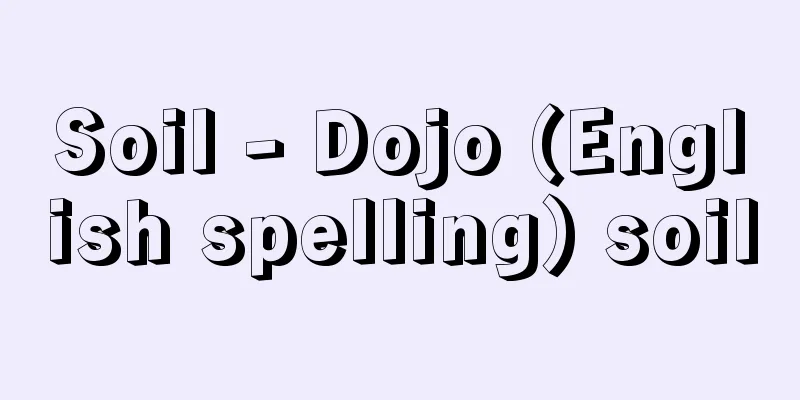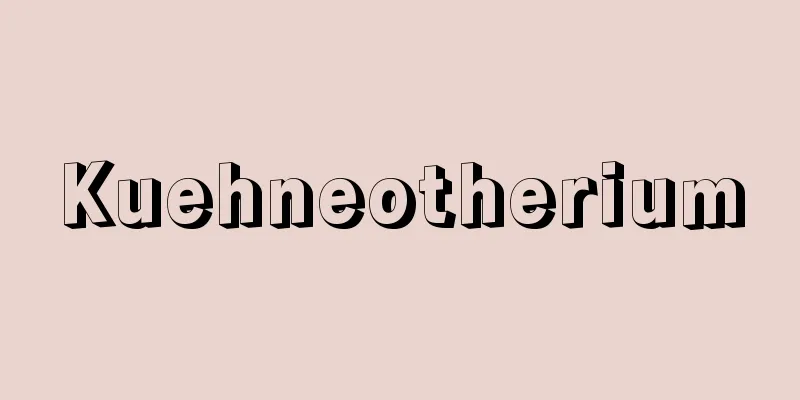Soil - Dojo (English spelling) soil

What is Soil?Soil is a product of the outermost layer of the earth's crust, a mixture of inorganic components made up of rock fragments and organic components resulting from the decomposition of animal and plant remains. It is considered desirable for the soil that covers the surface of land to have a physical structure (softness and gaps) and chemical components (nutrients) suitable for plant growth. This article will be limited to a description from the perspective of soil science in earth science and agricultural and forestry soil science, and for its relationship to human life and folk customs, please refer to the "soil" article. [Shigeo Asami and Makiko Watanabe] Soil research perspectiveSoil is a natural material that provides a place to live and nutrients for all living things that live on land. Humans are one of the living things that cannot survive without soil. For human beings, soil is a very important natural material. Soil resources are, so to speak, surface resources, as they are formed through a different process than metal resources such as iron and energy resources such as oil that are buried underground. While many underground resources are past geological products sandwiched within strata and have been through a long geological period of millions, tens of millions of years or more, soil resources are the product of recent alteration processes that occur only up to a depth of 1 to 2 meters from the surface of the earth. If we dig further, we reach the geological material known as bedrock, which is thought to have been altered to become soil by the alteration of bedrock that once existed near the surface. It is believed that it takes hundreds to thousands of years for soil to form near the surface of the earth. This is acknowledged by soil scientists who have studied a wide variety of soils around the world through research into (1) when the earth's surface was formed, (2) how much it has changed from the original rocks, and (3) what external forces have altered the original rocks. The timescale required for soil formation, which can range from hundreds to thousands of years, is orders of magnitude smaller than geological time. However, during that time, changes in the materials on the earth's surface have been progressing without rest, and will continue to change as long as the current earth's surface exists. Soil can be said to be a living natural material that is constantly changing. (1) When was the Earth's surface formed? Clarifying when and how the Earth's surface was formed is a field that investigates the process of landform formation based on the principles of geomorphology, that is, the research field of landform development history. The same type of soil is expected to be formed on a series of land surfaces that have the same landform formation process and era, that is, on the same topographical surface. (2) How much has it changed from the original rock? To determine how much the resulting soil has changed from the original rock, it is necessary to identify the soil profile morphology based on the principles of soil formation. Soils classified by soil profile type are classified into many types according to classification criteria from higher to lower orders, and their properties are described in detail. (3) External factors that altered the original rocks The most important external factors that affect the formation of soil are climate and vegetation; specifically, they are the factors that determine the movement of moisture near the surface of the earth and the quantity and quality of new organic matter added. Soil in agricultural land and forests plays a role in growing crops and trees, which are the raw materials for food, clothing, and shelter necessary for human beings. In the past, homes and transportation routes used exposed soil as is. Modern city dwellers live covered in asphalt and concrete, and have almost forgotten about soil, just like air. However, living soil exists under the grass in home gardens and parks, and some exposed ground remains. Street trees cannot grow without soil to take root. As urban environments expand, fewer people are taking an interest in soil, but isn't the quickest way for humans to come into contact with nature to tread on the soil and play with it? Soil is used to grow potted plants and bonsai. However, that soil is no longer "living soil." From the perspective of soil research, the starting point is to determine where in the natural land the soil comes from. Soil research has long been conducted in the fields of agricultural chemistry and crop science. The purpose of this research was to investigate the site conditions of agricultural crops and improve varieties and fertilization techniques. It can be said to be an applied science field that emphasizes the technical aspects of agriculture. For special purposes, pot cultivation tests are also conducted. On the other hand, there is research from a geoscientific perspective that investigates what process soil is formed and how its properties are expressed. This type of research was systematized by Dokuchaev, a pioneer of soil science in Imperial Russia at the end of the 19th century, and is called pedology (genetic soil science), and plays the role of basic science in soil research today. In contrast, soil research from an agricultural perspective, which has been conducted for a long time, is called edaphology (crop site soil science) and is distinguished from it. The notation in parentheses in pedology and edaphology here is not an appropriate translation, but merely a note that it means soil science. As an academic term, it is used in its kana form. However, there is soil research with a different purpose. For example, there is soil mechanics, which focuses on the strength of land foundations such as buildings and roads. Here, the issues are the properties of weathered layers or soft ground deeper than the soils that pedology and edaphology deal with. This article will focus on the perspectives and ideas regarding the formation, properties, and classification of soil from the perspective of pedology mentioned at the beginning. [Shigeo Asami and Makiko Watanabe] From the formation of land to surface weathering and soil formationWhen the Earth as a celestial body is divided into the lithosphere, atmosphere, and hydrosphere, the area where the lithosphere and atmosphere meet is the Earth's surface. Parts of land that were created by geomorphic processes at a certain time in geological time begin to change due to atmospheric processes (precipitation, temperature changes, etc.). Major landforms created by geomorphic processes include coastal plains that are raised from the seabed, layers of lava and volcanic ash caused by volcanic activity, and land with gravel deposits that spread in the basins of flooded rivers. Rainwater that falls on these newly created surfaces first penetrates the water, dissolving soluble chemical components contained in the surface layer of the lithosphere (bedrock, gravel layer, volcanic ash layer, etc.) as the air temperature and ground temperature change, and some of them are washed away underground. If the ground temperature changes above and below the freezing point, the rocks are mechanically destroyed by the freezing and thawing of water, and become finer. This process from the atmosphere is called weathering. Chemical decomposition is selective with respect to the minerals that make up the rock. Feldspars, olivine, and pyroxene are decomposed relatively quickly, and in terms of chemical composition, the dissolution of easily soluble bases such as sodium, potassium, and calcium precedes. This is just one example of chemical weathering. On the other hand, separation of brittle parts of rock tissue and collapse caused by differences in the coefficient of expansion in response to thermal changes are phenomena of physical weathering, along with the aforementioned freezing and thawing of moisture. As a result of weathering, a weathered zone (also called regolith) several tens of centimeters to several meters thick is created below the surface of the earth, but it is thickest in hot and rainy tropical regions and only a few dozen centimeters thick in the tundra of the polar regions. Another change seen near the surface of the earth is the emergence of living organisms and the accompanying biological weathering. Microorganisms first attach to the surface of rocks and broken rock fragments, and their secretions break down the inorganic components of the rocks, eventually leading to the growth of mosses and lichens, followed by the development of higher plants. Then, the activity of underground animals (earthworms, centipedes, ants, moles, etc.) joins in, and the interaction between these organisms leads to the production and accumulation of humus. Phenomena such as dissolution, washout, and redeposition of inorganic components, accumulation of humus components, and flow and precipitation of fine particles form specific soil layers in the upper part of the weathered zone near the surface. This process of formation is a step further from the initial weathering phenomenon, and differentiation of layers due to the vertical movement of materials occurs. The layers in this case are soil-specific layers that are essentially different from the strata found in geological deposits, so they are called soil horizons, and the stage after the differentiation of soil horizons begins is called soil formation. As mentioned above, differentiation of strata is thought to take hundreds to thousands of years, but there are exceptions where the strata change over a short period of time due to fluctuations in the groundwater level. In any case, it can be said that the formation of soil begins with the start of stratigraphic differentiation following weathering. Soil horizons are sometimes abbreviated to soil layers. In young soils that are only differentiated into two layers, the surface layer and the sublayer, it is acceptable to say the surface layer and the sublayer as long as there is no misunderstanding. The terms topsoil and subsoil are also used here. In developed soils, they are often divided into three layers: the leaching layer (A layer), the accumulation layer (B layer), and the soil parent material (C layer), and each of these layers may be further subdivided. [Shigeo Asami and Makiko Watanabe] Inorganic components and new productsThe inorganic components of soil can be divided into primary mineral particles and secondary minerals (new products produced during the process of weathering and soil formation). Primary minerals are mineral particles from the original rocks (considered to be the parent material of soil) that were present at the site and were highly resistant to weathering and tended to remain, including quartz, magnetite, zircon, and in the early stages of weathering, amphibole, pyroxene, and volcanic glass. These are residues of physical weathering with some chemical weathering added, and can be identified under a low-magnification stereomicroscope, ranging from those with well-preserved crystalline forms to those with rounded, amorphous forms. In contrast, secondary minerals are clay particles that are produced as new products after the loss of soluble chemical components, and are mostly colloids consisting of plate-shaped or needle-shaped crystals. They can be seen by electron microscopes, and their types can be identified by thermal analysis and X-ray diffraction techniques. Aluminosilicates such as the kaolinite group, montmorillonite, and allophane are known. Of these, allophane is characteristically found in weathered volcanic ash. The process by which new products are produced in soil is the result of chemical changes such as hydration, hydrolysis, oxidation, reduction, and chelation (combination of metal ions with organic matter). The phenomenon in which soluble components are washed away from sodium, potassium, and calcium salts is called base leaching, and the phenomenon in which some of these are deposited in another location in the soil layer (usually deep in the lower layer as water descends) is called accumulation. The leaching of bases causes the surface layer of the soil to become more acidic, and this tendency is stronger in terrestrial soils (soils other than hydrosoils with shallow groundwater) in temperate to tropical regions with high precipitation. [Shigeo Asami and Makiko Watanabe] Classification of soil typesThe classification of soil types derived from various soil formation processes is as follows: In temperate humid climates, secondary aluminosilicate minerals are stable. This state represents one stage of soil formation called siallitization. Brown forest soil is a typical example of soil that has matured at this stage. As one moves from the subtropics to the tropics, leaching of silicic acid becomes prominent, and the soil progresses to the alitization stage. In other words, iron and aluminum components accumulate in the form of oxides and hydroxides. Soils that have progressed to this stage are called red-yellow earths. Laterite (aluminum and iron aggregates) distributed in tropical savanna regions is considered to be the product of the extreme stage of alitization, and soils that have reached this stage are called latosols. In colder, more humid climates, the soil changes course and is dominated by podzolization, a process in which chemical weathering is accompanied by the decomposition of plant remains. This process is particularly prevalent in coniferous forests (taiga), which secrete highly active acidic humus, and creates a characteristic bleached layer of residual silicic acid (quartz grains) in the leaching layer of bases including iron and aluminum. The pH value of this layer is around 4, which indicates strong acidity. There are podzols in the taiga region, which are widely distributed in the high latitudes of the Northern Hemisphere, and gray and brown podzol soils in the subarctic zone. We have seen above how soil formation changes with temperature in humid climate regions. On the other hand, in dry climates, the direction of soil formation is relatively simple. In dry areas, where the amount of water flowing down through the soil is small and water loss occurs through capillary rise, the runoff of bases is suppressed, but even in prairies where precipitation is relatively high, calcium and magnesium salts accumulate in the lower layers of the soil. In steppe regions, calcium salts can accumulate in all layers of the soil. Chernozem, which spreads across the wheat belt from Central Europe to Central Asia, is distributed in response to these climatic conditions. As the degree of aridity increases, accumulation becomes limited to the surface. The soil formation process in dry regions can be said to be the simultaneous progression of lime accumulation and humus accumulation. In desert regions, weathering is limited to physical weathering, and soil formation is extremely suppressed. This condition is similar to that of beach sand and exposed rock on high mountains, and soil does not form on land without vegetation cover. It is known that between the steppe chernozem and the desert, soils are distributed in stages, from chestnut soil, gray soil, to desert soil, depending on the decrease in humus content. In arid regions, the phenomenon of salt (sodium salts) accumulation can be seen in localized depressions where a small amount of groundwater collects. Sodium salts dissolve easily with even a small amount of precipitation, but when water containing large amounts of sodium salts stagnates in the soil and becomes concentrated in depressions, sodium salts accumulate on the surface. Solonchaks are found scattered throughout the deserts of Central Asia, and when the precipitation characteristics of an arid climate sometimes cause environmental changes that result in the predominance of water falling within the soil, desalination (leaching of sodium salts) occurs, and alkalization (production of sodium hydroxide) occurs during the dissolution process. The resulting soil is called solonetz, and its pH value can be around 9. Another soil formation environment is gleyed soil, which occurs when the groundwater level is just below the surface. The groundwater table, which is usually several meters deep, does not directly affect the soil layers near the surface. In other words, the soil does not become overly wet except during rainfall or snowmelt. However, if there is a groundwater head about one meter below the surface, or if capillary water rises to that level, air infiltration is inhibited in the entire soil layer or in the lower layers, and a reducing state appears there. The soil in that area forms a gleyed horizon, so it is called gleyed soil. Gleyed soil refers to the appearance of a blue-gray horizon characterized by iron oxides. If the groundwater level drops, oxidation of iron occurs, and brown spots caused by iron oxides appear. Soils that are subject to gleyed soil include riverbank alluvial plains in lowlands and depressions in highlands. Localized poor drainage can also occur on plateaus and hills, so gleyed soil formation is thought to be widespread, though localized. Soils that are constantly gleyed include those found in the tundra of polar regions and high mountains. In seasons when the frozen soil near the ground surface melts, the meltwater from the topsoil supported by the permafrost creates a gleyed layer. Soils that exhibit the characteristics of gleyed soil formation, i.e., a bluish-gray layer that is nearly saturated with water and a layer adjacent to it that has iron oxide mottling, are collectively called gleyed soils. Soils in areas where rice is cultivated are a type of gleyed soil. However, the manifestation and inhibition of gleyed soil occurs in land that has been artificially managed, so the soil is not naturally altered. In lowland areas with poor drainage that would become flooded if left unattended, the moisture-saturated layer is lowered by constructing underdrainage systems, and when rice fields are opened up or double-cropped on plateaus, the position and development of the gleyed layer differs due to the effects of artificial flooding and drainage. Two-stage gleyed soils, such as those found in rice paddy soils on low plateaus, are observed to have a gleyed layer on the surface caused by artificial flooding, and a gleyed layer derived from natural groundwater in the lower layer. Andosols, found in areas with a lot of volcanic activity, including Japan, are soils that have been significantly affected by humus accumulation in lands covered with thick layers of volcanic ash. Renzinas, found in limestone areas from the temperate to subarctic zones, are also soils that show humus accumulation. These soils are recognized as not embodying the characteristics of so-called mature soils that have been sufficiently formed in the climate of the area in which they exist. However, in terms of the accumulation of humus components, they can be considered soils that are at a stable stage. [Shigeo Asami and Makiko Watanabe] Organic matter and humus formationThe organic components in soil are the result of the decay of living organisms (mainly the remains of higher plants) accumulating on the ground surface, mixing with inorganic components, and decomposing in various stages. In forests, the fermentation and decomposition of fallen leaves and dead undergrowth produces coarse brown decay material (moder humus), then fine black-brown matter mixed with inorganic soil particles (mullet humus), and eventually the biological tissue is completely lost, becoming colloidal particles (humus) that are always mixed with inorganic particles and stain the whole thing black. Humus can be classified into three main components: humic acid, fulvic acid, and humin. Of these, humic acid is experimentally separated by dissolving it in an alkaline solution and precipitating it with acid, and is divided into several types depending on the strength of its light absorption, and is used as an indicator of the stage of humification. Fulvic acid is thought to be the carrier of the podzolization process. The total amount of humus varies greatly depending on the type of soil and the upper and lower layers. In organic soils such as peat soil, the humus content is over 50% (by weight) in the surface layer, while in inorganic soils (all soils other than peat soil and black mud soil) it is around 10% in the surface layer. However, soils formed on volcanic ash layers can have a high humus content of around 20%. Almost all soils called black soil in Japan have volcanic ash as their base material, contain more than 15% humus, and are black or dark brown in color. The name andosol, derived from the Japanese word "an-do" (black soil), has become established as the worldwide name. [Shigeo Asami and Makiko Watanabe] Soil grain composition, texture and structureA given space in a soil layer consists of large and small solid particles and the gaps between them filled with water and air. These are called the solid, liquid, and gas phases of the soil, and the distribution of these three phases varies from top to bottom and from place to place. The inorganic and organic particles that make up the solid phase tend to become finer as the weathering progresses, but generally the volume of the gaps increases as the proportion of fine particles increases, and the volume ratio of the gaps in the soil layer (porosity) varies from 50 to 80% depending on the soil. Soil particles are considered to be approximately spherical solids, and particles with a diameter of 2 mm or more are classified into particle sizes every tenth of that size. 2 to 0.2 mm are called coarse sand, 0.2 to 0.02 mm are called fine sand, 0.02 to 0.002 mm are called fine sand, and particles below 0.002 mm are called clay, and this is the internationally established particle size classification method that defines the mechanical composition of soil particles. Japanese names such as sand and fine sand partially coincide with the names formerly established by the Agricultural Society of Japan, but because the cutoff values are different, when using the Japanese translation, it is necessary to state that they are based on international law. Now, to measure the particle size distribution according to this particle size classification, the sieving method is sufficient for fine sand, but for fine sand and clay, the particles must be separated using the underwater sedimentation method, spending eight hours. Furthermore, at that time, it is necessary to deflocculate and disperse the soil particles (returning them to their original colloidal state) using an acid or alkaline solution, which causes the adsorptive properties of the colloidal particles. Based on the mechanical composition of the analyzed soil particles (weight ratio for each particle size range), the percentages of sand, fine sand, and clay are plotted on a triangular coordinate system (graph), and the composition ratio of various large and small particles ranging from sand to clay according to a preset classification based on the provisions of international law is called soil texture and is displayed as one of the important physical properties. The difference in soil texture from one soil to another can be estimated by feel with your fingertips when observing the soil on site, but it requires some skill. The actual state of the solid phase and pores in the soil layer space cannot be grasped only by the mechanical composition and soil texture of the soil particles. This is because soil particles contain inorganic and organic colloidal particles, which form aggregates due to their adsorption properties. The aggregates are divided into several types depending on their shape and size, and are called soil structures. In addition to the spherical aggregate structure with a diameter of about 0.5 to 1 mm that is commonly seen in the surface layer of cultivated land, there are also structures such as dregs-like structures, nodule-like structures, plate-like structures, and columnar structures, and the degree of development of the structure varies depending on the type and ratio of secondary minerals (clay minerals) and the presence or absence of humus colloids. When soil particles stick together to form aggregates, the fine pores within the structure increase the water retention, while large pores are generated between the aggregates, which have the effect of draining excess water to the lower layer. On the other hand, if a soil layer made of fine-grained soil does not form aggregates and has a so-called wall-like structure (also called structureless), it can hinder water penetration and cause excessive moisture. In addition, soil particles in sandy areas where soil formation has not progressed are rich in sand particles and have a coarse texture, and have a single-grain structure that does not form aggregates, resulting in soil with poor water retention. [Shigeo Asami and Makiko Watanabe] Soil water statusWater in soil layers is in various physical states within the pores and exhibits various movements. It can be broadly divided into gravitational water (also called free water) that flows down through the large pores between aggregates, capillary water that fills relatively small pores and minute gaps within aggregates, and adsorbed water (hygroscopic water) that is adsorbed on the surfaces of colloidal particles. Capillary water can move slowly in all directions within the soil layer, and is often absorbed by plant roots. The water retention and water capacity of a soil layer depend mainly on the quantity and quality of the pores, but whether there is more washing-type descending water or more stagnant water also depends on the deep geological structure. [Shigeo Asami and Makiko Watanabe] Soil profile and horizon differentiationThe properties (physical and chemical) of each part of the soil layer change from the surface to the bottom. The changes in soil texture and structure can be felt by the touch of a fingertip or a trowel, and the transitional relationship of the humus and moisture content can be seen by color and brightness. A vertical cut into a soil layer is called a soil cross section, and capturing the characteristics such as color, granularity, moisture, structure and tissue seen there as cross-sectional morphology is the most basic means of investigating the formation of soil. When observing the soil profile in detail, it is possible to see the areas where the properties change relatively suddenly from the top to the bottom. The area where the blackness fades and turns to brown is the lower limit of the humus layer, and the area where the viscous brown fine-grained layer turns into a light-colored coarse-grained layer is where the influence of soil formation fades. Each part divided by color, soil type, structure, etc. is called a soil horizon, and while the cause of their differentiation is estimated from the mechanism of formation, they are considered to be the leaching layer (level) and the accumulation layer (level), and the general identification of the horizons is that the A horizon (level) and the B horizon (level), respectively. The part corresponding to the A horizon usually also has the characteristics of humus accumulation, and this can also be called the humus horizon (level). In some cases, the differentiation state of the horizons can be divided more finely. Also, when the podzolization process can be clearly seen in the cross-sectional shape, that is, the bleached layer where quartz sand remains due to intense base leaching, is called the E horizon (level). The lower layer, which has not yet been affected by leaching and accumulation, is called the C layer. This corresponds to the upper part of the regolith where soil formation has not yet begun, and can be thought of as the soil parent material, in the sense that it is the raw material for soil formation. When the cross-sectional form shows that soil formation has progressed sufficiently, it is classified as mature soil of type ABC. In contrast, types A (B) and C, where the development of the accumulation horizon is unclear, and types AC, which are in the early stages of formation, are also distinguished. Subterranean gleyed soils are sometimes called G horizons, and when there is a geological layer directly below the parent material (C horizon) that is discontinuous with the parent material and not directly involved in the formation of the soil at that site (for example, a gravel layer covered by a volcanic ash layer, or bedrock beneath a terrace deposit), it is sometimes called D horizon. Soil profiles indicate the degree of soil development. On the other hand, some, such as the BC type profile with the missing surface layer, show characteristics of surface runoff and soil erosion seen on slopes and plateau edges. In land covered by colluvial deposits and recent volcanic ash, the profile of previously mature soil is covered by the immature soil layer on the surface as a buried soil layer. In this case, multiple soil type profiles such as I (A), IC, IIA, IIB, and IIC can be seen. [Shigeo Asami and Makiko Watanabe] Agricultural production and soilCharacteristics of paddy field soil and its improvementCharacteristics of paddy soilIn paddy fields, an average of 1 million liters of irrigation water is supplied per 10 ares during the rice-growing season. This gives the soil a variety of characteristics that differ from those of upland fields. When observing the cross section of paddy field soil, characteristic layers are often seen, such as a peat layer formed by the action of water, which is an accumulation of organic matter, and a blue-gray or greenish-gray gley layer made of ferrous iron resulting from the reduction of iron. Also frequently seen are reddish-brown or yellowish-brown mottled iron-based oxide precipitates (iron speckles) that are clearly different from the soil's base color, and blackish-brown tubercles (nodules) made of manganese that have hardened more than the substrate. The characteristic of this type of paddy field soil profile is that the soil surface is cut off from the atmosphere by water, resulting in a poor supply of oxygen, and the soil becomes oxygen-deficient and in a reducing state due to the oxygen consumption by soil microorganisms that decompose organic matter. There are two types of paddy field soil: dry paddy fields, in which the topsoil is in a reduced state with a lack of oxygen during the flooded period, but the lower layers are in an oxidized state, and wet paddy fields, in which the groundwater level is high and the entire layer is in a reduced state. The reason why the lower part of paddy field soil when flooded with water is often blue-gray is because iron is reduced to form divalent ferrous iron. Like iron, manganese is also reduced to form divalent manganese. Iron and manganese in this reduced state are more soluble in water than when they are oxidized, so they migrate to the lower layers as the water seeps in. Therefore, iron and manganese generally decrease in the topsoil of paddy fields, and accumulation is seen in the lower layers. As this makes clear, the properties of soil are well reflected in the soil profile.になったんです。 English: The first thing you can do is to find the best one to do. [Yuki Koyama] Aging paddy fieldsになったんです。 English: The first thing you can do is to find the best one to do. This phenomenon is called "fall fall." To improve such aging paddy fields, red soil in the mountains and silt in ponds and swamps are good. This is because the lack of iron, silica and manganese are replenished. Furthermore, by deep tilling and rewinding the soil over the top and the ground, iron and manganese that have moved to the lower layer are returned to the surface to improve the soil. Furthermore, application of iron-containing materials such as limonite bauxite sachet and fertilizer soil, and application of silicic acid and manganese containing lime silicates are also effective. Furthermore, in order to prevent the generation of hydrogen sulfide, application of sulfur-free root fertilizers such as salt-anan, and "medium-drying" to temporarily drop irrigation water in the summer to prevent the paddy field soil from becoming oxygen deficiency is also effective. [Yuki Koyama] The wetlands and their dry fieldsになったんです。 English: The first thing you can do is to find the best one to do. [Yuki Koyama] Reclaimed soilIn reclaimed soil, growth disorders such as salt, acid, reduction, and alkaline damage occur in rice at the beginning of reclamation. This is because salinity (mainly sodium chloride) caused by the influence of seawater and sulfides accumulated in large amounts below the sea surface are oxidized after reclamation due to the influence of seawater, resulting in sulfuric acid being formed, resulting in strong acidification of the soil. Therefore, for improving reclamation soil, methods such as establishing an irrigation drainage facility to remove these salt and sulfuric acid, neutralizing soil acidity with carbonated lime, and applying straw. [Yuki Koyama] The characteristics of field soil and its improvementsFarm soil characteristicsIn Japan, most of the flat and convenient areas with good water use are used for paddy fields, so farmlands are concentrated in plateaus, foothills, and hill areas that are inconvenient for water management. Therefore, there are many slopes, and slopes of 5 degrees or higher account for almost half of the total area of the field. Therefore, due to the effects of heavy rains and seasonal monkeys, nutrients and sometimes even soil particles are lost, and soil particles tend to be damaged by soil erosion. Furthermore, as a result of the loss of potassium, calcium, magnesium, etc., the soil tends to become acidic or nutrient deficiency, leading to a decline in the soil's strength. In this way, Japanese farm soils are not always in good condition due to their natural environment, and so-called poor soils, which have soil production inhibitors such as acidic soil, heavy clay, poor volcanic soil, sandy soil, gravel soil, stale soil, manganese-deficient soil, and boron-deficient soil, according to the Basic Survey of Earth Power Conservation conducted between 1959 and 1978 (Showa 34-53), amounting to about 70% of ordinary farm soil. On the other hand, Japan is one of the world's leading volcanic countries, so there are extremely many fields affected by volcanic ash. This is one of the most distinctive features seen in comparison with other countries. In addition to these characteristics, Japanese farm soils lack the habit of crop rotation like in Western Europe, and single vegetables are growing on a large scale and causing continuous cropping problems. Furthermore, livestock farming based on the land is not popular, leading to continuous cropping problems, and the ground strength is generally low. The production level is clearly inferior to paddy fields and compared to Western European farming. Therefore, improvements are necessary. [Yuki Koyama] Field soil and its improvementsになったんです。 English: The first thing you can do is to find the best one to do. This is due to the overall improvement effect, which increases the buffering capacity of the soil and improves microbiota rather than directly correcting the acidity of the soil. (2) Volcanic ash soil About 50% of the fields in Japan are volcanic ash soil, and most of the uncrowded land is volcanic ash soil, so the full-scale development of field farming and grassland agriculture depends on how to improve this volcanic ash soil. Volcanic ash soils were treated as synonymous with low-producing regions until before World War II, but now many of them are excellent cultivated land. The effects of these improvements have largely been attributed to the results of improvement technologies, such as (a) enrichment of high-quality organic matter through compost manure, (b) correction of acidity with lime, and (c) improvement of soil by applying large amounts of leaching phosphorus fertilizer. (3) Other In addition to acidic soil and poor volcanic ash soil, Japan also has field soil that requires soil improvement, such as heavy clay, peat soil, sandy soil, and gravel soil. The improvement of heavy clay and peat soil requires the development of a production base mainly based on drainage. In addition, for sandy soil and gravel soil, the most effective means is to use clay soil soil. However, all of these problems are the huge cost. Therefore, in reality, it is important to implement crop rotations and implement crop rotations, improve fertilization methods, improve the vegetation of these poor soils through means such as mulching (soil covering), and deep tilling. [Yuki Koyama] になったんです。 English : The first thing you can do is to find the best one to do . "Environmental Soil Studies: Soil Studies as the Human Environment" (1993, Asakura Shoten)" ▽ "Kuma Kazuto, Sakuma Toshio, Shoji Sadao, Suzuki Ko, Hattori Tsutomu, Mido Masanori, Wada Mitsushi, "Encyclopedia of Soil" (1993, Asakura Shoten)" ▽ "Kimura Masato, Nio Ichio, Marumoto Takuya, Kanazawa Shinjiro, Tsutsuki Kiyoshi, and others, "Soil Biochemistry" (1994, Asakura Shoten)" ▽ "Kuma Kazuto, "Latest Soil Studies" (1997, Asakura Shoten)" ▽ "Kawada Hiroshi, "Introduction to Forest Soil Studies" (2000, Hakutomosha)" ▽ "Introduction to Inventory of Soil Studies" (2000, Hakutomosha)" ▽ "In Inubushi Kazuyuki, Anzai Toshio, Umemiya Yoshiaki, Goto Itsuo, Seino Keishi, Tsutsuki Kiyoshi, and Matsunaka Teruo" ▽ "Introduction to Soil Studies" (2001, Asakura Shoten)" ▽になったんです。 English: The first thing you can do is to find the best one to do . [Reference Items] | | | | | Soil| | | | | | | | | | | | | |©Shogakukan "> Soil distribution around the world Source: Shogakukan Encyclopedia Nipponica About Encyclopedia Nipponica Information | Legend |
土壌とは土壌とは、岩石の破片からなる無機成分と動植物の遺体が分解して生じた有機成分とが混合した、地殻最表層の生成物をいう。陸地の表面を覆う土壌は、植物の生育に適した物理的構造(柔らかさとすきま)および化学的成分(栄養分)をもつことが望ましいとされている。本項においては、地球科学の土壌学と農林土壌学の観点からの記述にとどめ、人間生活および民俗とのかかわりについては「土」の項を参照されたい。 [浅海重夫・渡邊眞紀子] 土壌研究の視点土壌は、陸地に生息するすべての生物に生きるための場所と栄養を与える自然物である。人間も土壌なしには生存することのできない生物の一つである。人類にとって、土壌という自然物はたいへん重要な資源とみることができる。土壌資源は、地下に埋蔵されている鉄などの金属資源や石油などのエネルギー資源とは生成過程を異にする、いわば地表資源というべきものである。多くの地下資源が地層内に挟在した過去の地質生成物で数百万年、数千万年あるいはそれ以上の長い地質時代を経ているのに対し、土壌資源は地表からせいぜい1~2メートルの深さまでの新しい変質作用の産物である。さらに掘り進めばいわゆる基盤岩石とよぶ地質物質に達するが、かつて地表付近まであったこの基盤岩石が変質して土壌になったのだと考えられる。地表付近で土壌が生成するには、数百年から数千年の時間がかかると思われている。そのことは、(1)地表がいつできたか、(2)元の岩石からどの程度変わっているか、(3)元の岩石を変質させた外界の作用はどのようなものであったか、などを考える研究を通じて、世界各地で多種多様な土壌の研究を行った土壌学者が認めていることである。土壌生成に要する数百年ないし数千年というタイムスケールは、地質学の時代に比べて桁(けた)違いに小さい。しかしその期間に地表の物質の変化が休みなく進められてきたのであり、現在の地表面が存続する限りなお変化し続けるのである。土壌はつねに変わりつつある生きた自然物ということができる。 (1)地表がいつできたか 地表がいつごろどのようにしてできたかを解明するのは、地形学の原理に基づく地形形成過程の追究、すなわち地形発達史の研究分野である。地形の形成過程とその時代を同じくする一連の地表面、すなわち同一地形面に、同種の土壌の生成が期待される。 (2)元の岩石からどの程度変わっているか 生成した土壌が元の岩石とどのように変わっているかを判定するには、土壌生成の原理に基づく土壌断面形態の認定が必要である。土壌断面タイプによって分類される土壌は、高次から低次までの分類規準に従って多くの種類にわたり、その性質が詳しく記載される。 (3)元の岩石を変質させた外界の作用 土壌の生成に関与した外界の作用としてもっとも重要なものは気候と植生であり、具体的には、地表付近の水分の動きや新たに加わる有機物の量と質を決める諸因子である。 農耕地や樹林地の土壌は、人類に必要な衣食住の原材料としての作物や樹木を育てる役割を果たしている。かつては住居も交通路も土の露出した地面をそのまま利用していた。現代の都会人はアスファルトやコンクリートに覆われた暮らしをしているので、土壌を空気と同様にほとんど忘れてしまっている。しかし家の庭や公園の芝生の下には生きた土があり、裸出した地面もすこしは残されている。街路樹も根を張る土壌がなければ育たない。都市的環境の拡大につれて、土壌に関心をもつ人が減りつつあるが、人間が自然に接するいちばんの近道は土を踏み泥いじりをすることではなかろうか。鉢植えの草花や盆栽作りには土が使われる。しかしその土は「生きた土壌」ではなくなっている。土壌を研究する立場からいえば、自然の土地のどの場所のものであるかが出発点である。 土壌の研究は古くから農芸化学や作物学の分野で行われてきた。その研究の目的は、農作物の立地条件を調べ、品種の改良や施肥技術の向上を図ることにあった。農学のなかでも技術面を強調した応用科学的分野といえよう。特殊な目的のためにはポット栽培試験なども行われる。一方、土壌とはいかなる生成過程をもつ物質か、その性質はいかにして発現したかなどを究明するいわば地球科学的視野にたつ研究がある。このような研究は、19世紀末の帝政ロシア時代における土壌学の先覚者ドクチャーエフによって体系づけられ、ペドロジーpedology(成因論的土壌学)とよばれて、今日の土壌研究における基礎科学の役割を果たしている。これに対して古くから行われていた農業面からの土壌研究は、エダフォロジーedaphology(作物立地土壌学)とよばれて区別される。ここでいうペドロジーとエダフォロジーに付した( )内の表記は適切な訳語とはいえず、その意味の土壌学という注記にすぎない。学術用語としては仮名書きのままで使われている。 なお、これらとは別の目的をもつ土壌研究がある。たとえば建築物や道路などの土地基盤の強度について視点を向けた土質力学である。ここではペドロジーやエダフォロジーの扱う土壌よりも深い風化層あるいは軟弱地盤の特性が問題となる。本稿では最初に述べたペドロジーの視点から、土壌の生成・性質・分類に関する見方、考え方を中心に記述していく。 [浅海重夫・渡邊眞紀子] 陸地の形成から地表の風化・土壌化天体としての地球を岩石圏(リソスフェア)、気圏、水圏と分けるとき、岩石圏と気圏が接するところ、それが地表面である。地質時代のある時期に地形形成作用によって生じた陸地の一部は、大気圏からの作用(降水、気温変化など)を受けて変化し始める。地形形成作用によるおもな地形には、海底の隆起した海岸平野、火山活動による溶岩と火山灰の層、氾濫(はんらん)する河川の流域に広がる砂礫堆積(されきたいせき)物の土地がある。新たに生じたこれらの地表に降る雨水はまず浸透し、気温・地温の変動に伴って岩石圏表層部(基盤岩石、砂礫層、火山灰層など)に含まれている可溶性化学成分を溶解し、その一部を地下に流し去る。氷点を上下する地温の変化があれば、岩石は水分の凍結融解によって機械的に破壊され、細粒化していく。大気圏からのこのような働きを風化作用という。 化学的分解作用は、岩石を構成している鉱物に対して選択的に行われる。長石類や橄欖(かんらん)石、輝石などは比較的早く分解され、化学成分でみればナトリウム、カリウム、カルシウムなどの易溶性塩基の溶解が先行する。これは化学的風化の一例にすぎない。一方、岩石組織のもろい部分が分離したり、熱変化に対する膨張係数の違いでおこる崩壊は、先の水分凍結融解作用とともに物理的風化の現象である。風化作用の結果、地表下数十センチメートルないし数メートルの厚さの風化帯(レゴリスともいう)が生ずるが、高温多雨の熱帯地方でもっとも厚く、寒帯のツンドラ地方ではわずか十数センチメートルにすぎない。 地表付近にみられるもう一つの変化は、生物の発生とそれに伴う生物学的風化である。岩石面や破壊岩片の表面にはまず微生物が着生し、その分泌物により岩石の無機成分が分解され、やがて蘚苔(せんたい)類・地衣類の生育から高等植物の発達に進む。さらに地中動物の活動(ミミズ、ムカデ、アリ、モグラなど)も加わり、それらの生物の相互作用のもとに腐植の生成・集積が行われていく。 無機成分の溶解・流失・再沈積、腐植成分の集積、微小粒子の流下・沈殿などの現象は、地表付近の風化帯の上部に特有の土壌層を形成させる。この形成過程は初期の風化現象からさらに一歩進んだ段階にあって、物質の垂直方向の移動に由来する層の分化がおこっている。この場合の層とは、地質堆積物にみられる地層とは本質的に異なる土壌特有の層であるから、これを土壌層位とよび、土壌層位の分化が始まった段階以後を土壌化とよぶのである。層位の分化は前述のように数百年から数千年を要すると考えられるが、例外的には地下水位の変動などによる短年月の層位変化もある。いずれにせよ土壌の生成は、風化に続く層位分化の始まりによって開始されるといってよい。 土壌層位を略して土壌層ということもある。表層位と下層位の2層に分化しただけの若い土壌では、表層・下層といっても誤解されない限りは通用する。またここで表土・下層土という言い方もある。発達した土壌では、溶脱層位(A層)、集積層位(B層)、土壌母材(C層)の三つの層位に分かれることが多く、この各層位をさらに細分することもある。 [浅海重夫・渡邊眞紀子] 無機成分と新生成物土壌の無機成分を一次鉱物粒子と二次鉱物(風化・土壌化の過程で生じた新生成物)とに分けることができる。一次鉱物は、その場にあった元の岩石(土壌の母材とみる)中の鉱物粒子のうち、風化に対する抵抗力が大きく残留しやすかったもので、石英、磁鉄鉱、ジルコンや、風化の初期には角閃(かくせん)石、輝石、火山ガラスなども含まれている。これらは物理的風化に若干の化学的風化が加わった程度の残留物で、結晶形がよく保たれているものから丸みを帯びた不定形のものまで、低倍率の実体顕微鏡下で識別できる。これに対し二次鉱物とは、可溶性化学成分の流失したあとに新生成物として生じた粘土粒子であって、多くは板状や針状の結晶体からなるコロイドである。電子顕微鏡によって姿をとらえられるほか、熱分析やX線回折の手法で種類を鑑定する。カオリナイト鉱物群、モンモリロナイト、アロフェンなどのアルミノケイ酸塩が知られている。このうちアロフェンは火山灰の風化物に特徴的に含まれる。 新生成物が土壌中につくられてゆく過程は、水和、加水分解、酸化、還元、キレート化(金属イオンと有機物との化合)などの化学変化から導かれる。可溶性成分がナトリウム塩・カリウム塩・カルシウム塩から流亡する現象を塩基の溶脱といい、その一部が土層内の別の位置(普通は下降水の動きに伴って下層の深部)に沈積する現象が集積である。塩基の溶脱によって土壌の表層は酸性に傾き、降水量の多い温帯から熱帯にかけての陸成土壌(地下水の浅い水成土壌以外の土壌)ではこの傾向が強い。 [浅海重夫・渡邊眞紀子] 土壌型の分類各種の土壌化作用から導かれる土壌型の分類をみると次のようになる。 温帯湿潤地方の気候の下では、アルミノケイ酸塩の二次鉱物が安定している。この状態はシアリット化作用siallitizationとよぶ土壌化の一段階を示している。この段階で成熟した土壌の代表は褐色森林土である。亜熱帯から熱帯に近づくとケイ酸の溶脱が顕著になり、アリット化の段階に進むことになる。すなわち、鉄・アルミニウムの成分が酸化物・水酸化物の形で集積をおこす。この段階まで進んだ土壌は赤黄色土(せきおうしょくど)とよばれる。熱帯サバンナ地方に分布するラテライト(アルミニウム・鉄の塊状集積物)は、アリット化作用の極点における生成物とみなされ、この段階に近づいた土壌をラトソルとよぶ。 寒冷多湿の気候に向かうと、土壌化の進路は一転し、化学的風化に植物遺体の分解物が関与するポドゾル化作用に支配される。この作用は活性の強い酸性腐植を分泌する針葉樹林帯(タイガ)でとくに盛んとなり、鉄・アルミニウムまで含めた塩基類の溶脱層位に、残留物としてのケイ酸(石英粒)が特徴的な漂白層をつくる。この層位のpH値は4前後という強度の酸性を示している。北半球の高緯度に広く分布しているタイガ地方のポドゾル、および亜寒帯の灰色・褐色ポドゾル性土がある。 以上、湿潤気候地域の寒暖の違いによる土壌化の推移をみた。一方、乾燥気候の下では、土壌化の方向は比較的単純である。土壌中を下降する水分量が少なく、毛管上昇による水分の損失がおこる乾燥地では、塩基の流亡が抑えられることになるが、比較的降水量の多いプレーリーの草原でも土壌の下層にカルシウム・マグネシウムの塩類が集積している。ステップ地帯では土壌の全層にカルシウム塩の集積がおこりうる。中部ヨーロッパから中央アジアにかけての小麦地帯に広がるチェルノゼムが、この気候条件に対応して分布する。さらに乾燥度が進むにしたがい、集積は地表部に限定されるようになる。乾燥地域の土壌化作用は石灰集積化と腐植集積化の同時進行といってよい。砂漠地方では風化作用も物理的風化にとどまり、土壌の生成は極度に抑制される。その状態は海浜の砂地や高山の露岩地と同様で、植被のない土地には土壌が生じないのである。草原のチェルノゼムから砂漠に至る間に、腐植量の減少に応じて、栗色(くりいろ)土、灰色土、砂漠土と段階的に分けられた土壌の分布が知られている。 乾燥地域には若干の地下水が集まる局所的凹地に塩分(ナトリウム塩類)集積化の現象がみられる。ナトリウム塩はわずかの降水によって簡単に溶解するのであるが、これを多量に含んだ水分が土壌内に停滞し、凹地では濃縮されるので、ナトリウム塩が地表に集積してしまう。中央アジアの砂漠に点在するソロンチャクがそれで、乾燥気候の降水特性により、ときには土壌内の下降水が卓越するような環境変化を受けると、脱塩化(ナトリウム塩の溶脱)がおこり、その溶解過程でアルカリ化(水酸化ナトリウムの生成)がおこると考えられる。こうして生じた土壌はソロネッツであり、そのpH値は9前後になることがある。 いま一つの土壌生成環境として、地下水位が地表直下にあるためにおこるグライ化がある。普通数メートル以上の深さにある地下水面は地表付近の土壌層にその直接の影響を及ぼすことはない。すなわち降雨時か融雪期を除いて、土壌は過湿にならないのであるが、地表下1メートル付近に地下水頭が存在するか、毛管水の上昇がそのあたりまでみられる場合、土壌の全層または下層において空気の侵入が抑止され、そこに還元状態が出現する。その部分の土壌がグライ層位をなしているのでグライ化とよぶ。グライ化とは、二価鉄の酸化物に特徴づけられる青灰色の層位の出現をさす。もし地下水位が低下すると、鉄の酸化がおこり、三価鉄の酸化物による褐色の斑紋(はんもん)が現れる。低地の河岸沖積地や高冷地の凹地などにグライ化作用を受けている土壌がある。台地や丘陵地にも局地的排水不良がおこりうるので、グライ化という土壌化作用は局地的ながら広く点在すると考えられる。恒常的にグライ化をおこしている土壌としては極地や高山地のツンドラにみられるものがある。地表付近の凍結が融(と)ける季節に、永久凍土層に支えられた表土の融解水がグライ層を生じさせる場合である。グライ化作用の特徴、つまり土壌層内に水分を飽和に近く含んだ青灰色の層位や、それに接する酸化鉄の斑紋をもつ層位が認められる土壌を、総称的にグライ性土と称する。 水稲栽培地の土壌はグライ性土の一種である。しかしそのグライ化作用の発現・抑止などが人為的に管理された土地でおこっているので、自然の土壌化作用そのままではない。低地の排水不良地で放置すれば湛水(たんすい)田の状態になる場合は、暗渠(あんきょ)排水などの施工で水分飽和層を下げることが行われるし、台地上の開田や二毛作田をつくる場合は、人為的冠水、落水の影響でグライ層位の位置や発達度は違ってくる。低い台地の水田土壌などにみられる2段グライ型のものは、表層の人為冠水によるグライ層と、下層の自然地下水に由来するグライ層とが分かれて観察される土壌である。 降下火山灰の厚い累層に覆われる土地において、日本をはじめ火山活動の多い地域に分布するアンドソルは、腐植集積作用を著しく受けた土壌である。また、温帯から亜寒帯の石灰岩地に分布するレンジナも腐植化を示す土壌である。これらの土壌については、存在地の気候の下で十分な生成作用を受けたいわゆる成熟土としての特性を具現していないものとの認識がある。しかし腐植成分の集積の面から、安定した一つの段階にある土壌とみることができる。 [浅海重夫・渡邊眞紀子] 有機成分と腐植生成土壌中の有機成分は、生物体(主として高等植物の遺体)の腐朽物が地表に蓄積しつつ無機成分と混在し、いろいろの段階に分解したものである。森林では落葉と枯れた下草の発酵分解により、粗粒の褐色腐朽物(モーダー型腐植)、次に微粒の黒褐色物が無機質土粒との混合(ムル型腐植)、やがて生物組織が完全に失われ、つねに無機粒子と混在して全体を黒く染めるコロイド質微粒子(腐植)となる。腐植は腐植酸、フルボ酸、ヒューミンhuminの三つの主成分に分類でき、このうち腐植酸は実験的にアルカリ液に溶け酸で沈殿することで分離され、その吸光性の強弱によって数種の型に分けられ、腐植化の段階を決める指標に使われる。フルボ酸はポドゾル化作用の担い手と考えられている。腐植の全量は土壌の種類により、また上下層位によって大きく差がある。泥炭土のような有機質土壌では表層で50%(重量比)以上、無機質土壌(泥炭土・黒泥土以外のすべての土壌)の表層で10%前後。しかし火山灰層に生成した土壌の場合、20%前後の高い腐植含有率をもつものがある。日本で黒(くろ)ぼく土とよばれる土壌のほとんどすべては火山灰を母材としており、15%を超す腐植物質を含んで黒色ないし暗褐色を呈する。世界的名称として、日本語の暗土に由来したアンドソルが定着するようになった。 [浅海重夫・渡邊眞紀子] 土粒の構成および土性と構造土層内の一定空間をとってみると、大小の固形粒子とその間隙(かんげき)を満たす水分および空気からなっている。これらを土壌の固相・液相・気相と称し、この3相の分布状態が土層の上下で、また各地の土壌によりさまざまな特徴を表している。固相をなす無機・有機の粒子は風化段階に応じて細粒化していく傾向があるが、一般に微粒子の組成割合が増大するほど間隙の容積が増え、間隙の土層内に占める容積比(孔隙率)は土壌によって50~80%の開きがある。土壌粒子を近似的に球形の固形物とみなし、直径2ミリメートル以上をレキ(礫)として以下10分の1ごとに粒径区分していく。2~0.2ミリメートルを粗砂、0.2~0.02ミリメートルを細砂、0.02~0.002ミリメートルを微砂、0.002ミリメートル以下を粘土と名づけ、土粒の機械的組成のくぎりとしたのが、国際的に定められた粒径区分法である。砂、微砂などの日本名はかつて日本農学会法で定められた名称と部分的に一致するが、くぎりの値が違うので、日本訳を使うときは国際法によると断る必要がある。さて、この粒径区分に従って粒度分布を測るには、細砂までは篩別(ふるいわけ)法でよいが、微砂・粘土は水中沈底法で8時間を費やして粒子を分離しなければならない。さらにその際、コロイド粒子の吸着性に由来する土粒の集合体を、酸またはアルカリ液によって解膠(かいこう)分散する(元のコロイドの状態に戻す)処置が必要となる。 分析された土粒の機械的組成(各粒径区ごとの重量比)をもとに、砂・微砂・粘土のパーセント値を三角座標(グラフ)にプロットし、あらかじめ設定された、国際法の規定に基づく区分に従って砂質から粘土質まで多様な大小粒子の構成割合を土性とよんで、重要な物理性の一つとして表示する。土壌による土性の違いは、現地観察の際、指先の感覚でも見当はつくが、やや熟練を要する。 土壌の土層空間における固相・孔隙の実態は、実は土粒の機械組成と土性だけではつかみきれない。それは、土粒が無機・有機のコロイド質微粒子を含み、その吸着性による集合体をつくっているからである。集合体は、形状・大きさによって数種類の型に分けられ、土壌構造とよばれる。耕地の表層によくみられる径0.5~1ミリメートル前後の球状団粒構造のほか、屑粒(くずりゅう)状構造、団塊状構造、板状構造、柱状構造などがあり、二次鉱物(粘土鉱物)の種類と割合、腐植コロイドの有無などによって構造の発達度が異なる。土粒が膠着して集合体をつくると、構造体内の微細な孔隙が保水性を高めると同時に、集合体どうしの間に粗大な孔隙が生じて過剰な水分を下層に排出する効果がある。一方、細粒質土性からなる土層が集合体をつくらず、いわゆる壁状の構造(無構造ともいう)である場合、水の浸透を妨げたり過湿状態をもたらしたりする。また土壌化の進んでいない砂地などの土粒は、砂粒に富んで粗い土性からなり、集合体をつくらない単粒構造をなすため、保水性の悪い土壌となる。 [浅海重夫・渡邊眞紀子] 土壌水の状態土層中に存在する水は、孔隙内でさまざまな物理的状態をなし、種々の動きをみせる。集合体間の大きな孔隙を下降する重力水(自由水ともいう)、比較的小さな孔隙や集合体内の微細なすきまを満たしている毛管水、コロイド粒子の表面に吸着されている吸着水(吸湿水)に大別される。毛管水は土層内をゆっくりとあらゆる方向に動きうる水で、植物の根に吸収される機会が多い。土層の保水力、容水量は主として孔隙の量と質に左右されるが、洗浄型の下降水が多いか停滞型の水分が多いかは、深部の地質構造にもよる。 [浅海重夫・渡邊眞紀子] 土壌断面と層位分化土層内の各部の性質(物理性・化学性)は、地表から下部に向かって変化している。土性や構造の変わるようすは指先や移植ごての触感でわかり、腐植分や水分の状態は色や明るさ暗さでその移行関係をみることができる。土層を垂直に切り割った切り口を土壌断面といい、そこにみられる色、粒状、湿り気、構造と組織などの特徴を断面形態としてとらえることが、土壌の成り立ちを究明するうえでのもっとも基本的な手段である。 土壌断面を詳細に観察すると、上層から下層へ比較的性質が急変する部分をとらえることができる。黒みが減って褐色に移るところは腐植層の下限とし、粘性の高い褐色の細粒層が淡色の粗粒層に変わるところは土壌化の影響が薄れる部分である。色、土性、構造などによって分けられた各部分を土壌層位とよび、その分化する原因を生成作用の仕組みから推定しながら、上から溶脱層(位)、集積層(位)とみなし、それぞれA層(位)、B層(位)というのが一般的な層位の識別である。A層にあたる部分は同時に腐植集積の特徴をもつことが普通で、ここを腐植層(位)とよんでもよい。層位の分化状態はもっと細かくくぎりを入れることができる場合もある。またポドゾル化作用を断面形態に明瞭(めいりょう)に読み取れる場合、すなわち激しい塩基溶脱により石英砂の残った漂白層はE層(位)とする。溶脱・集積の作用がまだ及ばない下部層は、C層(位)とよばれるが、この部分は土壌化の始まっていないレゴリス上部にあたり、土壌生成を受けるべき原材料という意味で土壌母材と考えることができる。 土壌生成が十分に進んだ断面形態を示す場合、ABC型の成熟土となる。それに対して集積層位の発達が不明瞭なA(B)C型、生成の初期にあるAC型などが区別される。地下水成グライ層はG層(位)、母材(C層)の直下に母材とは不連続でその場の土壌生成に直接関与しない地質的異層(たとえば火山灰層に覆われる礫層、あるいは段丘堆積層の下の基盤岩石)がある場合、それをD層と名づけることがある。 土壌断面は土壌の発達度を表している。その一方表層の欠如したBC型断面のように、傾斜面や台地縁などにみられる表層流亡型、土壌侵食の特徴を示すものもある。また崩積物や新期火山灰によって覆われた土地では、埋没土層としてかつての成熟土の断面が現地表面の未熟土層の下に覆われる。この場合はⅠ(A)、ⅠC、ⅡA、ⅡB、ⅡCのような多元土壌型の断面がみられる。 [浅海重夫・渡邊眞紀子] 農業生産と土壌水田土壌の特性とその改良水田土壌の特性水田では、稲作期間中に10アール当り平均100万リットルほどの灌漑(かんがい)水が供給される。このため畑とは違った土壌の特徴がいろいろとみられる。水田土壌の断面を観察すると、水の影響によってできた有機物の集積した泥炭層や、鉄の還元により生ずる二価鉄でできた青灰色ないし緑灰色のグライ層などの特徴的な層がよくみられる。また、土壌の基色と明らかに異なる赤褐色、黄褐色の鉄を主とする酸化沈殿物の斑紋(班鉄)や、黒褐色で基質よりも硬化したマンガンを主とする結核(団塊)などもしばしばみられる。 このような水田土壌断面の特徴は、水により土壌表面が大気と遮断される結果、酸素の供給量が乏しく、しかも有機物を分解する土壌微生物の酸素消費によって、土壌が酸素不足の還元状態となるためである。 水田土壌には、水を張った湛水(たんすい)期間中で表土は酸素不足の還元状態となるが下層は酸化状態となっている乾田と、地下水位が高く全層が還元状態となっている湿田とがある。水が張られた状態の水田土壌の下部が多く青灰色を呈しているのは、鉄が還元を受けて二価鉄ができるためである。鉄と同様にマンガンも還元を受け二価マンガンとなる。これら還元状態にある鉄、マンガンは酸化状態の場合よりも水に溶けやすくなるために、水の浸透に伴って下層へと移行する。したがって、一般に水田の作土では鉄とマンガンが減少し、下層では集積がみられる。これからも明らかなように、土壌の性質はその土壌断面によく反映される。水田土壌の分類では、この断面形態に重点を置いた土壌調査が1953年(昭和28)より実施され、日本の水田土壌は泥炭土壌、泥炭質土壌、黒泥土壌、グライ土壌、強グライ土壌、灰色土壌、灰褐色土壌、黒色土壌、黄褐色土壌、礫層(れきそう)土壌、礫質土壌の11の土壌類型に大別された。現在では日本の土壌分類は水田ばかりではなく、農耕地全体に共通な基本的分類区分としての土壌統が用いられている。土壌統とは、ほぼ同じ材料から同じような過程により生成されたほぼ等しい断面形態をもつ一群の土壌の集まりのことをいう。このようにして設定された土壌統には全国各地の地名が付けられている。その総数は320である。このような科学的な分類とは別に、一般に使われている農業生産上とくに土壌の生産力阻害要因をもつ、問題となるおもな水田土壌は次のようである。 [小山雄生] 老朽化水田作土から浸透水により鉄の溶脱が進み、作土が著しい鉄不足をおこしている状態の水田をいう。花崗(かこう)岩などの酸性岩や砂岩などを母材とした水田は粘土分が少なく透水性がよいので、鉄、マンガンなど多くの土壌成分が下層に流失するので老朽化水田になりやすい。この老朽化水田では水を張ると土壌がしだいに酸素不足の状態となり、肥料などにより施された硫酸塩が還元を受け硫化水素ができる。普通の水田では鉄が豊富にあるので、硫化水素は鉄と反応して不活性な硫化鉄となって沈殿するので問題はおこらないが、老朽化水田では鉄が不足しているので、一部の硫化水素がそのままの状態で土壌中に残る。硫化水素は生物毒性が強いので水稲の根が被害を受け、ひどい場合では根が腐ってしまう。地温が上昇すると硫化水素の発生も急激に多くなるので、水稲は夏を過ぎるころからにわかに生育が不良となり著しい減収を招く。この現象を「秋落ち」とよんでいる。 このような老朽化水田を改良するには、山の赤土や、池・沼の沈泥の客土がよい。これは、不足している鉄、ケイ酸、マンガンが補給されるためである。また深耕、天地返しすることによって、下層に移動した鉄やマンガンが表層に返されて土壌が改良される。また、褐鉄鉱ボーキサイトかす、肥鉄土などの含鉄資材の施用、ケイ酸、マンガンを含むケイ酸石灰の施用も効果がある。さらに硫化水素の発生を防止するため、塩安などの無硫酸根肥料の施用や水田土壌が酸素不足とならないように、夏期一時的に灌漑水を落として土壌を乾燥させる「中干し」も有効な手段である。 [小山雄生] 湿田とその乾田化排水工事など長い間の努力の結果、あまりみられなくなったが、日本の水田には水はけが悪く冬期も水の抜けない谷津田(やつだ)などの湿田があり、地下水位が高く一年中乾燥することがない。未熟な有機物が多量に集積し、軟弱で酸素不足の還元状態を呈している。地温は一般に低く作柄が安定しない。このような湿田を改良して水稲作の安定多収と機械化、裏作物を栽培して土地の利用度を高めるなどの具体化を図るには、排水することによって過剰の水を除いて、水田を乾田化しなくてはならない。このため、素焼土管、陶管、塩化ビニル管や、丸太、粗朶(そだ)、石礫などを用い地下に通水路を設けて排水する暗渠(あんきょ)排水や、ポンプを用いて余分な水を排水路から排水する明渠(めいきょ)排水が行われている。 [小山雄生] 干拓地土壌干拓地土壌では干拓の当初に塩害、酸性害、還元害、アルカリ害などの生育障害が水稲でしばしば発生する。これは、海水の影響による塩分(主として塩化ナトリウム)と海面下に多量に集積した硫化物が、干拓後大気の影響で酸化される結果、硫酸ができて土壌が強酸性化するからである。したがって干拓地土壌の改良には、灌排水施設を設けてこれらの塩分や硫酸を排水除去する、炭酸石灰などで土壌酸性を中和する、生藁(わら)を施用する、などの方法が有効である。 [小山雄生] 畑土壌の特性とその改良畑土壌の特性日本では平坦(へいたん)で水利の便のよい所はそのほとんどが水田に利用されているので、畑地は水管理に不便な台地や山麓(さんろく)、丘陵地帯に集中している。したがって傾斜地が多く、5度以上の傾斜地は畑地総面積のほぼ半分を占めている。このため、豪雨や季節風などの影響を受けて、土壌中の養分やときに土壌粒子までが流失するなど土壌侵食の被害を受けやすい。またカリウム、カルシウム、マグネシウムなどが失われる結果、土壌が酸性に傾いたり、養分欠乏に陥ったりして地力が低下しがちである。 このように日本の畑土壌は、その置かれている自然環境のためにかならずしも恵まれた状態ではなく、酸性土、重粘土、不良火山性土、砂質土、礫質土、苦土、マンガン欠乏土、ホウ素欠乏土などの土壌生産阻害要因をもつ、いわゆる不良土壌は1959~1978年(昭和34~53)に行われた地力保全基本調査によると、普通畑土壌の約7割にも達している。 一方、日本は世界有数の火山国であるため、火山灰の影響を受けた畑地がきわめて多い。これは諸外国と比較した場合にみられる際だった特色の一つである。 このような特性のほか、日本の畑土壌は西欧のような輪作の習慣に乏しく、単一の野菜を大規模に連作して連作障害をおこしている。また土地に立脚した畜産が盛んでないことから連作障害が現れやすく、また地力も概して低い。その生産力水準は水田に比べても、また西欧の畑作と比べても明らかに劣っている。したがってその改良が必要である。 [小山雄生] 畑土壌とその改良(1)酸性土壌 気候が温暖で雨量の多い日本では有機物(腐植)の分解が進み、土壌中の有機物含量が低下している。また、塩基の流亡、ことにカルシウムの流亡が激しく、畑土壌はおおむね酸性となっている。土壌が酸性に傾くと土壌中のアルミニウムが活性化して、リン酸などの陰イオンは固定され作物に利用できなくなる。またアンモニウム、カルシウムなどの陽イオンは雨水で流亡しやすくなる。またある種の土壌では、置換性マンガンが増加して作物がマンガン過剰障害を引き起こすこともある。このため酸性土壌では一般に作物の生育は不良となる。その改良にあたっては炭酸カルシウム、ケイ酸カルシウム、消石灰などのカルシウム資材の施用によって、土壌の酸性反応を矯正することが先決である。しかし今日では酸性の矯正がかなり進み、逆にアルカリ性を呈する土壌もみられるので適正なカルシウム資材による矯正が必要である。一方、不足しがちな土壌有機物含量を改善するため、堆肥、厩肥(きゅうひ)、緑肥など有機物の施用も効果がある。これは土壌の酸性を直接矯正する効果よりも、土壌の緩衝能力が増したり、微生物相が改善されたりする総合的な改良効果による。 (2)火山灰土壌 日本の畑地の約50%が火山灰土壌であり、また未耕地の大部分が火山灰土壌であるので、畑作農業や草地農業の本格的発展は、この火山灰土壌をいかに改良するかにかかっている。 火山灰土壌は第二次世界大戦前までは低位生産地の代名詞のように扱われてきたが、現在は優良な耕地となっている例が多い。このような改良の効果をもたらしたのは、(a)堆厩肥による優良有機物の富化、(b)石灰による酸性の矯正、(c)溶成リン肥の多量施用による土壌改良、などの改良技術の成果によるところが大きい。 (3)その他 酸性土、不良火山灰土以外にも日本には重粘土、泥炭土、砂質土、礫質土など土壌改良を必要とする畑土がある。重粘土、泥炭土の改良には排水を主体とした生産基盤の整備が前提となる。また砂質土、礫質土では粘土質の土壌の客土がもっとも有効な手段である。しかしこれらはいずれも莫大(ばくだい)な経費を要する点に問題がある。したがって実際には、作付体系をくふうし輪作を行う、施肥法を改善する、マルチング(土壌被覆)、深耕などの手段によってこれら不良土の植生を改善する、などのことがたいせつである。 [小山雄生] 『川村一水・船引真吾著『農林土壌学』改著版(1960・養賢堂)』▽『石川昌男著『農家の土壌学』(1977・農山漁村文化協会)』▽『山根一郎他著『図説 日本の土壌』(1978・朝倉書店)』▽『土質工学会土のはなし編集グループ編『土のはなし』全3巻(1979・技報堂出版)』▽『地学団体研究会編『土と岩石』(1982・東海大学出版会)』▽『大羽裕・永塚鎮男著『土壌生成分類学』(1988・養賢堂)』▽『松井健著『土壌地理学特論』(1989・築地書館)』▽『E・M・ブリッジズ著、永塚鎮男・漆原和子訳『世界の土壌』(1990・古今書院)』▽『松井健・岡崎正規編著『環境土壌学――人間の環境としての土壌学』(1993・朝倉書店)』▽『久馬一剛・佐久間敏雄・庄子貞雄・鈴木皓・服部勉・三土正則・和田光史編『土壌の事典』(1993・朝倉書店)』▽『木村真人・仁王以智夫・丸本卓哉・金沢晋二郎・筒木潔他著『土壌生化学』(1994・朝倉書店)』▽『久馬一剛編『最新土壌学』(1997・朝倉書店)』▽『河田弘著『森林土壌学概論』(2000・博友社)』▽『犬伏和之・安西徹郎編・梅宮善章・後藤逸男・妹尾啓史・筒木潔・松中照夫著『土壌学概論』(2001・朝倉書店)』▽『浅海重夫編『大学テキスト 土壌地理学』(2001・古今書院)』▽『日本土壌肥料学会・ペドロジスト懇談会監修・久馬一剛・永塚鎮男編『土壌学と考古学』(2001・博友社)』▽『久馬一剛著『熱帯土壌学』(2001・名古屋大学出版会)』▽『長谷川和久著『土壌と生産環境』(2002・養賢堂)』▽『土壌物理学会編『新編 土壌物理用語事典』(2002・養賢堂)』▽『国際食糧農業協会編『世界の土壌資源――入門&アトラス』全2冊(2002・古今書院)』▽『日本ペドロジー学会編『日本の統一的土壌分類体系』(2003・博友社)』▽『久馬一剛著『土とは何だろうか?』(2005・京都大学学術出版会)』 [参照項目] | | | | | | | | | | | | | | | | | | |©Shogakukan"> 世界の土壌分布 出典 小学館 日本大百科全書(ニッポニカ)日本大百科全書(ニッポニカ)について 情報 | 凡例 |
<<: Soil pollution - Dojo Osen (English)
>>: Loach (Misgurnus anguillicaudatus)
Recommend
Kinyo Wakashu - Kinyo Wakashu
This was the fifth imperially commissioned anthol...
Legislative proposal - Giinrippo
Legislation based on an initiative (also called a...
Scyllarides haani (English spelling) Scyllaridesshaani
… [Takeda Masatomo]. … *Some of the terminology t...
Rheum webbianum (English spelling) Rheum webbianum
… [Hiroshi Wakamatsu]. … *Some of the terminology...
Kuehneotherium
...Among these cynodonts, the first mammals were ...
Symptomatic pneumothorax
… [Takeshi Yoshitake]. … *Some of the terminology...
Insulating pipe - Insulating pipe
...The purpose of the arc horn is to cause a flas...
Agastache rugosa (Fisch.et Mey.) O.Kuntze
A perennial plant of the Lamiaceae family that gro...
Gertrud von le Fort
1876‐1971 A female writer born to a Huguenot arist...
Boron nitride (boron nitride)
Chemical formula: BN. It is produced by mixing sod...
Sumida River
(In the past, it was also written as "Sumida ...
The Republic of the Five Races (English: Wu-zu gong-he)
A slogan advocated during the Xinhai Revolution in...
Foreign exchange securities - Gaitameshoken
Please see the "Foreign Exchange Fund Securi...
Prefectural governor - Kenrei
Governor of prefectures from 1871 to 1886. After ...
Hugues Capet
938-996 Founder of the Capetian dynasty, King of F...



![Irrigator (English spelling) [Germany]](/upload/images/67caf3da3b535.webp)





